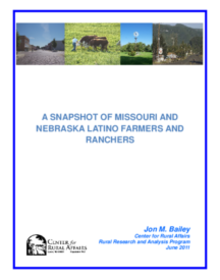Farm and Food
This report highlights selected data from the 2007 U.S. Department of Agriculture Census of Agriculture on several aspects of Latino farmers and ranchers in Missouri and Nebraska. These data provides a broader view of the current status of Latino farmers and ranchers in both states.
Summary of data
- Both states are experiencing a decline in the number of farms operated by Latinos.
- Farms with a Latino principal operator in Missouri are generally smaller than in Nebraska, however, more Nebraska Latino principal operators farm in the smallest category of farm size. In both states, small farms are more likely to be operated by Latinos.
- Latino principal operators in Missouri are in greater numbers in the lower farm economic classifications, while Latino principal operators in Nebraska are in far greater numbers in the highest farm economic classification, likely as a result of farm size.
- Missouri farms with Latino principal operators also have higher rates of USDA “small family farm” typologies than do Nebraska farms as well as higher rates of so-called “lifestyle” and “retirement” farms. Nebraska farms with Latino principal operators, on the other hand, have significantly higher rates of farms with higher sales (so-called “commercial” or primary occupation farms), large and very large family farms and non-family farms. Again, this corresponds to the differences in farm size and farm economic classifications between farms with Latino principal operators in both states.
- A significantly higher percentage of Missouri Latino principal operators are full owners of their farms than in Nebraska. This may also be connected with farm size, i.e., it is relatively easier to be the full owner of a small farm than a farm of several hundred acres.
- Most Latino farm households in Missouri and Nebraska do not make most of their income from farming or ranching. However, a significantly larger number of Nebraska farm households make 75 percent or more of their income from farming.
- A primary occupation other than farming is more common among Missouri Latino principal operators. As such, more Missouri Latino principal operators work more days off the farm.
- Nebraska Latino principal operators are slightly older than Missouri Latino farmers, but Nebraska also has more young (under 25 years of age) Latino principal operators.
- Latino farmers who are the principal operators of farms are almost exclusively male. However, both states have a relatively high rate of female farmers who are not principal operators.
- Latino farmers in both states are involved in traditional agricultural activities—crop and grain farming and beef cattle ranching, with crop and grain farming more popular in Missouri and beef cattle ranching more popular in Nebraska. However, significant portions of Latino farmers in both states are involved in non-traditional agricultural pursuits.
- A small number of Latino farmers in both states receive USDA agricultural loans, with more Latino farmers receiving payments from USDA conservation programs and other USDA agricultural programs than from USDA loan programs.


